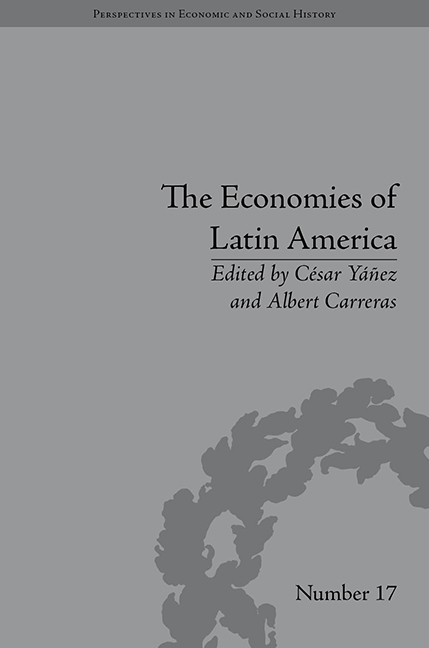Book contents
- Frontmatter
- CONTENTS
- List of Figures and Tables
- List of Contributors
- Preface
- Introduction: Latin American Economic Backwardness Revisited
- 1 Expectations, Institutions and Economic Performance: Latin America and the Western European Periphery during the Twentieth Century
- 2 On the Accuracy of Latin American Trade Statistics: A Non-Parametric Test for 1925
- 3 Latin America and Its Main Trade Partners, 1860–1930: Did the First World War Affect Geographical Patterns?
- 4 The Structure of Latin American Investment in Equipment Goods during the Mature Period of the First Globalization
- 5 Factorial Distribution of Income in Latin America, 1950–2000: New Series from the National Account Data
- 6 The Influence of the First World War on the Economies of Central America, 1900–29: An Analysis From a Foreign Trade Perspective
- 7 Economic Modernization in Adverse Institutional Environments: The Cases of Cuba and Chile
- 8 Capital Goods Imports, Machinery Investment and Economic Development in the Long Run: The Case of Chile
- 9 The Sugar Industry, the Forests and the Cuban Energy Transition, from the Eighteenth Century to the Mid-Twentieth Century
- 10 Empirical Debate on Terms Of Trade and the Double Factorial Terms of Trade of Colombia, 1975–2006
- 11 Public Revenues in Bolivia, 1900–31
- 12 The Consumption of Durable Goods in Latin America, 1890–1913: Analysis and Estimation of a Demand Function
- Notes
- Index
11 - Public Revenues in Bolivia, 1900–31
- Frontmatter
- CONTENTS
- List of Figures and Tables
- List of Contributors
- Preface
- Introduction: Latin American Economic Backwardness Revisited
- 1 Expectations, Institutions and Economic Performance: Latin America and the Western European Periphery during the Twentieth Century
- 2 On the Accuracy of Latin American Trade Statistics: A Non-Parametric Test for 1925
- 3 Latin America and Its Main Trade Partners, 1860–1930: Did the First World War Affect Geographical Patterns?
- 4 The Structure of Latin American Investment in Equipment Goods during the Mature Period of the First Globalization
- 5 Factorial Distribution of Income in Latin America, 1950–2000: New Series from the National Account Data
- 6 The Influence of the First World War on the Economies of Central America, 1900–29: An Analysis From a Foreign Trade Perspective
- 7 Economic Modernization in Adverse Institutional Environments: The Cases of Cuba and Chile
- 8 Capital Goods Imports, Machinery Investment and Economic Development in the Long Run: The Case of Chile
- 9 The Sugar Industry, the Forests and the Cuban Energy Transition, from the Eighteenth Century to the Mid-Twentieth Century
- 10 Empirical Debate on Terms Of Trade and the Double Factorial Terms of Trade of Colombia, 1975–2006
- 11 Public Revenues in Bolivia, 1900–31
- 12 The Consumption of Durable Goods in Latin America, 1890–1913: Analysis and Estimation of a Demand Function
- Notes
- Index
Summary
Introduction
Latin American economic history is not always able to take regional economic diversity into account. The main reason is the lack of quantitative data which is particularly severe in the case of Bolivia. The present study goes one step towards remedying this with a presentation of two long-term series. Revising primary data brings a) the central state's fiscal income between 1900 and 1931; b) the mining fiscal burden between 1900 and 1929. However, this study goes beyond a mere descriptive strategy and proposes some interpretative clues to understand income evolution. The point is to study the Bolivian public finances taking into account its own restrictions. Undoubtedly, the central state fiscal income was strongly determined by the trade taxes. But looking at the profitability and – paradoxically – the stability of all the revenue sources, there was not a real option in the short or medium term. This research also shows that the mining fiscal burden grew considerably in the 1920s.
Economic history cannot always encompass the great economic diversity of Latin America. It is not unusual to find works understanding and defining the region basically from the study of the more developed countries in relative terms. This option can constitute a methodological approach. Nevertheless, it is usually no more than a resignation due to the lack of data, especially quantitative data.
Significant efforts taking into account every Latin American state are being made to fill the blanks.
- Type
- Chapter
- Information
- The Economies of Latin AmericaNew Cliometric Data, pp. 167 - 178Publisher: Pickering & ChattoFirst published in: 2014



